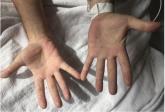Opinion

Wave, surge, or tsunami
- Author:
- Chi-Cheng Huang, MD, FACP, SFHM
- William C. Lippert, MD, MPH
- Bill Payne, MBA
- Manoj Pariyadath, MD
- Padageshwar Sunkara, MD, MMCi, FACP, FHM
Publish date: July 14, 2020
Predictive models for COVID-19 have strengths and weaknesses and none are perfect.
News

Doing things right vs. doing the right things
- Author:
- Padageshwar Sunkara, MD, MMCi, FACP, FHM
- William C. Lippert, MD, MPH
- Christopher Morris, MD
- Chi-Cheng Huang, MD, FACP, SFHM
Publish date: April 13, 2020
There has been inconsistent guidance in regard to the containment of COVID-19 within health care systems.
Article

A woman, age 35, with new-onset ascites
- Author:
- William C. Lippert, MD, MPH
- Eun Y. Lee, MD
- Aibek E. Mirrakhimov, MD
She also has jaundice, hepatomegaly, and multiple abnormal laboratory results. What is the next step?
News

How should asymptomatic hypertension be managed in the hospital?
- Author:
- William C. Lippert, MD, MPH
- Paula Bailey, MD, MHA
- And Adam J. Gray, MD
Publish date: May 1, 2018
The appropriate treatment of hypertension in the inpatient setting is suboptimal due to the lack of guidelines and inconsistent management.
Article

Methemoglobinemia in an HIV patient
- Author:
- Riva Raiker, MD
- William C. Lippert, MD, MPH
- Romil Chadha, MD, MPH, FACP, SFHM
He had restarted his home dapsone prophylaxis, but his dyspnea worsened and his urine became dark.
